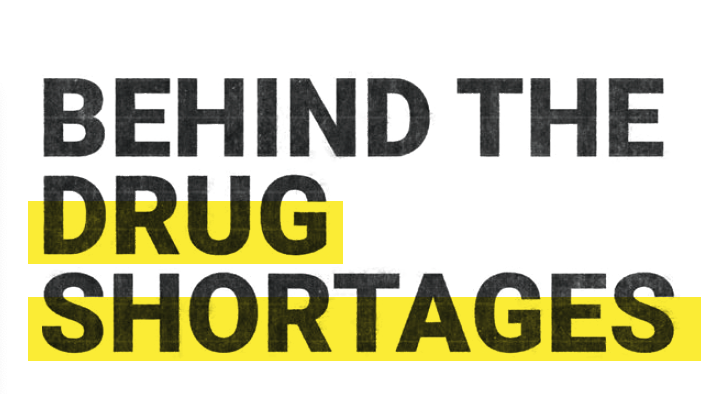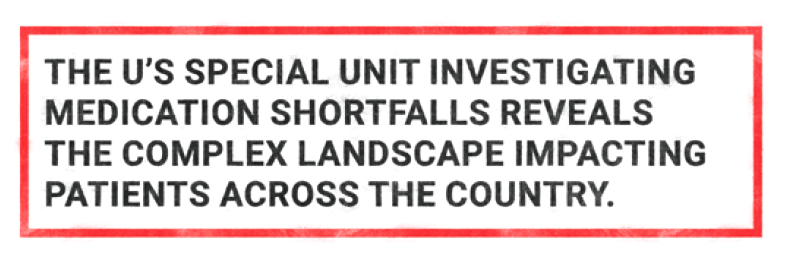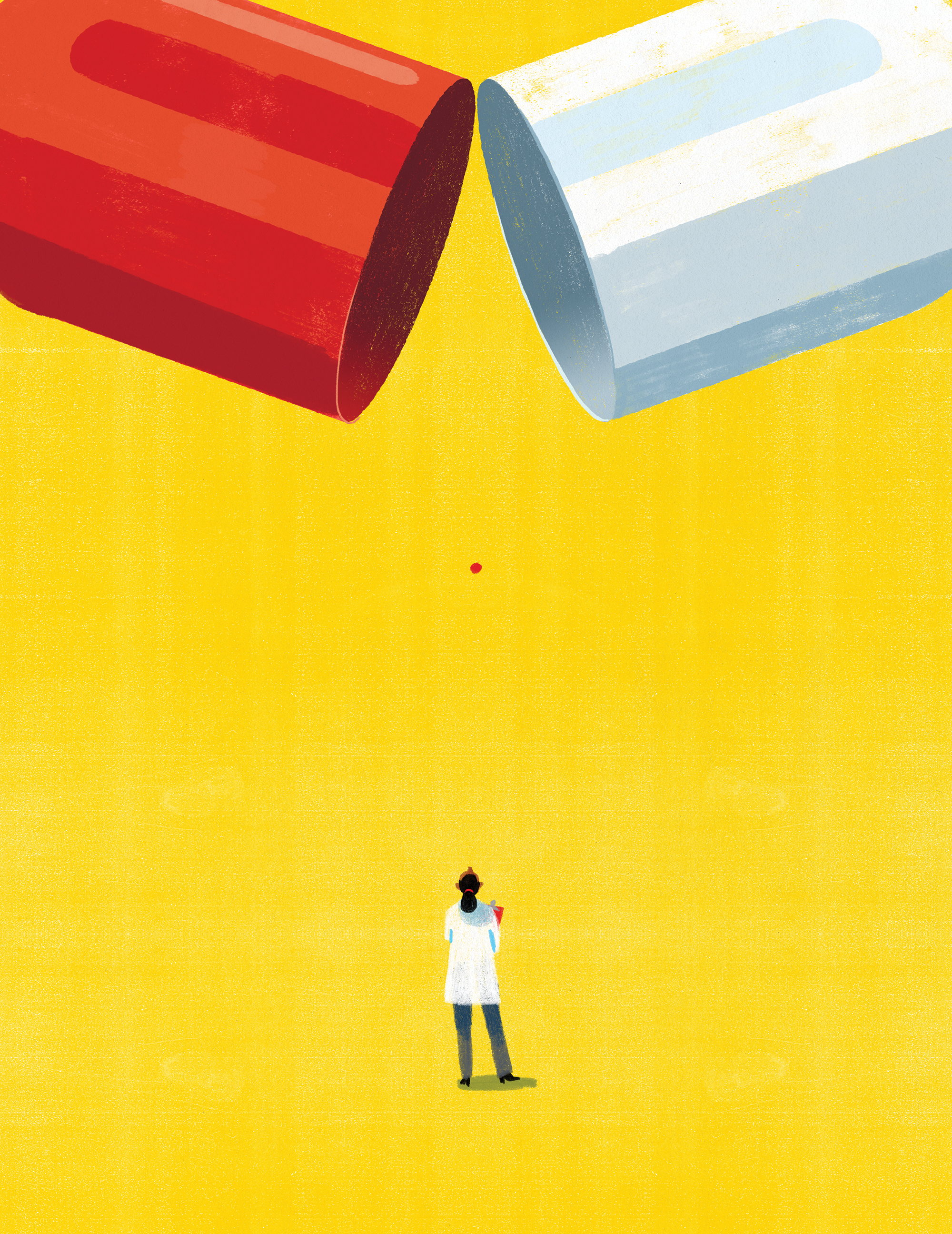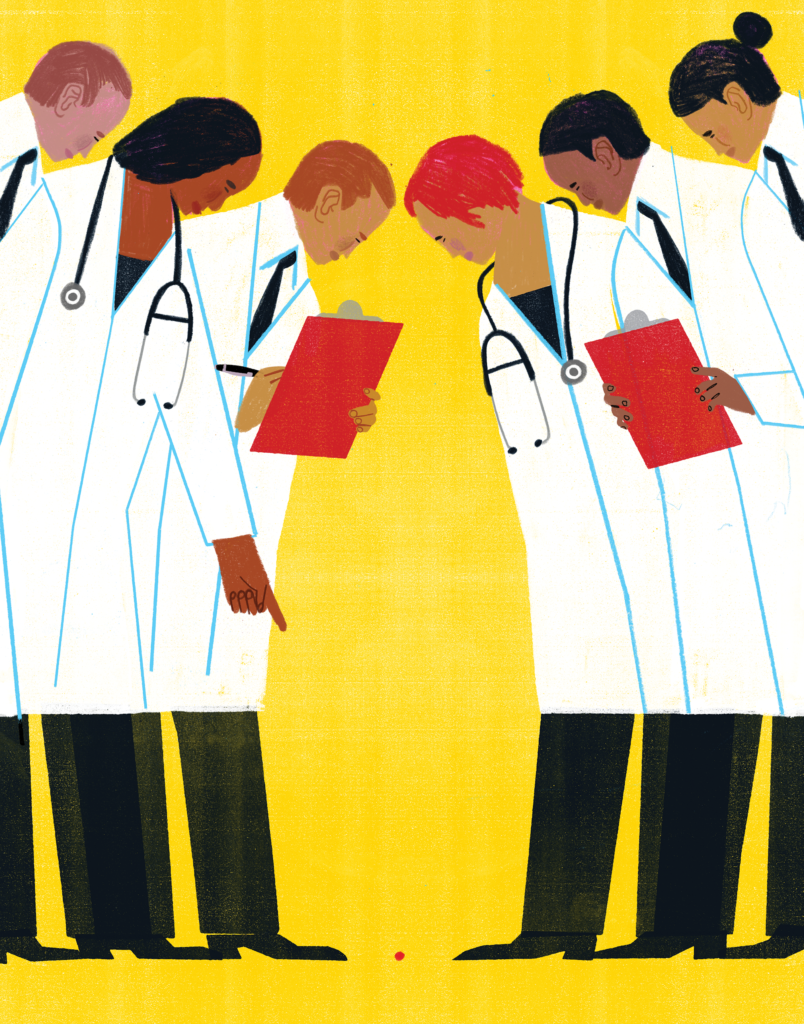

BY ELAINE JARVIK
ILLUSTRATIONS BY KEITH NEGLEY

 robably no one’s going to make a six-season medical drama about the work she and her team do, agrees Erin Fox BA’94 PharmD’99 MHA’23. After all, what would the scenes be? A spreadsheet, a phone call, yet another Zoom meeting?
robably no one’s going to make a six-season medical drama about the work she and her team do, agrees Erin Fox BA’94 PharmD’99 MHA’23. After all, what would the scenes be? A spreadsheet, a phone call, yet another Zoom meeting?
But sometimes it’s important to tediously amass page after page of data to reveal how patients’ lives are in peril.
For over two decades, the University of Utah’s Drug Information Service (DIS) has been methodically investigating and logging prescription drug shortages, providing a nationwide database that has become indispensable for hospitals, think tanks, and lawmakers. Along the way, Fox—associate chief pharmacy officer and head of DIS—has become a go-to national expert.
In 2023, she was quoted in print and interviewed on-air more than 5,000 times. Last March she was one of four experts who testified before Congress about how drug shortages impact national security, and in May she testified about the effect on patients’ wallets.
There she was, yet again, a pleasant woman patiently explaining that behind each shortage is a manufacturing and reporting system that woefully lacks transparency. Once again, asked why a particular drug is in short supply or when the situation will improve, she had to explain that sometimes it’s frustratingly impossible to find out.

The most recent prescription drug shortages span the alphabet from acetazolamide to zoledronic acid and include some 300 drugs in between, from simple saline to life-saving chemotherapy. But when Fox joined the Drug Information Service in 2000, shortages were rare and poorly understood.
Linda Tyler BPH’78 PharmD’81, currently clinical professor in the U’s College of Pharmacy, was head of the DIS then and remembers a pivotal encounter with a cantankerous oncology doc. When she explained that a chemotherapy drug was in short supply, the doctor asked her which “irresponsible pharmacists” were in charge. “No, no, we have a great team,” Tyler explained. “We’ve been trying to buy more of that drug for six weeks.” In those days, even the U.S. Food and Drug Administration didn’t have a drug shortages division, and the doctor was leery.
So Tyler came up with a plan to involve physicians earlier in the process. That led to alerts written on bright red paper (“cherry memos,” she called them). Then, as shortages began to snowball, she realized that there needed to be a national database, so that every hospital and clinic in the country could know if a shortage was local or widespread, fleeting or dire. That led to a partnership with the 60,000-member American Society of Health-System Pharmacists (ASHP), whose website has posted the U’s data since 2001.
“It’s become a resource that everyone relies on in the industry,” says Eric Tichy, division chair of Pharmacy Supply Solutions at the Mayo Clinic and board chair of the End Drug Shortages Alliance.
These days, nearly every hospital in the U.S. has at least one person whose sole job is managing shortages, Fox says. Nationwide, that adds up to $365 million a year in extra labor costs. At University of Utah Health, there are DIS staff members who investigate and verify each shortage report, and others who are on the phone all day tracking down any remaining vials of a drug in short supply or researching alternate meds (which might cost more, not work as well, or cause more toxic side effects).
 The hospital drugs most commonly in short supply are generic sterile injectables (GSIs, in hospital lingo): crash cart drugs, antibiotics, morphine, oxytocin. The fact that these drugs are inexpensive is, counterintuitively, at the heart of the problem.
The hospital drugs most commonly in short supply are generic sterile injectables (GSIs, in hospital lingo): crash cart drugs, antibiotics, morphine, oxytocin. The fact that these drugs are inexpensive is, counterintuitively, at the heart of the problem.
When former Utah Sen. Orrin Hatch teamed up with Sen. Henry Waxman in 1984 to pen the Drug Price Competition and Patent Term Restoration Act (“Hatch-Waxman” for short) the idea was to save Americans money by making it easier for manufacturers to reverse-engineer bioidentical, cheaper versions of expensive brand-name drugs once patents have expired.
The unintended consequence of all that money saved, however, has turned out to be what Fox and others call “a race to the bottom.” The problem is that hospitals, subject to government insurance spending caps, are encouraged to buy the least expensive drugs available. The injectables, though, amount to mere pennies of profit for the manufacturers, and are complex to make and crucial to get right: unlike oral medicines, where impurities can be filtered by the digestive system, the injectables go directly into the bloodstream. Trying to make them inexpensively means that some manufacturers cut corners in dangerous ways.
Hospitals often have no way of knowing, though, which manufacturers these are, or which corners have been cut—or of knowing in advance whether the manufacturers will suddenly be forced to shut down or will decide it’s too much trouble to keep going.
Generic drug manufacturers aren’t required to publicly reveal details, even about which products they make or where they get the raw ingredients from. If the FDA discovers something amiss during an inspection, it keeps much of it redacted in public reports because the information is deemed proprietary, says Fox. The reports end up looking like a checkerboard of gray rectangles where key revelations should be.
 To compound the problem, U.S. manufacturing infrastructure is deteriorating, and an increasing number of GSIs or their raw ingredients are now manufactured abroad, largely in India and China, where the FDA inspects the facilities but often runs into problems: because of visa concerns, the inspections are announced in advance, and quality control is sometimes lax, deceptive, or both.
To compound the problem, U.S. manufacturing infrastructure is deteriorating, and an increasing number of GSIs or their raw ingredients are now manufactured abroad, largely in India and China, where the FDA inspects the facilities but often runs into problems: because of visa concerns, the inspections are announced in advance, and quality control is sometimes lax, deceptive, or both.
The details are alarming: incriminating test results stuffed into plastic bags and hidden away, falsified test results, birds flying around sterile labs, urine in buckets next to sensitive machinery, workers wearing gloves with holes in them, barefoot workers, mold on the walls, metal shavings in the vials.
Because hospitals have no way of knowing which generic drug manufacturers are reliable, the only criterion they can base purchases on is price. And since manufacturers can only compete on price, there is no incentive to be safer, or to make ample supplies of a drug. Sometimes, weary of trying to meet FDA quality demands, or weary of making minimal profit, plants shut down or switch to making brand-name drugs that can bring big profits for their shareholders.
Most shortages take hospital pharmacists by surprise. And there isn’t enough refrigerator space to keep more than several months of a drug in reserve just in case. And, too, there is the ethical question of whether a hospital should hoard a bigger supply.
In 2023, the American Society of Clinical Oncology began advising doctors to administer dwindling supplies of chemotherapy medications just to patients with a higher chance of surviving, a potentially deadly form of triage.
U of U Health, including Huntsman Cancer Institute, has been lucky so far, says clinical pharmacist Tom Sanders. “We’ve had 12 or 13 high-impact oncology shortages, but we haven’t reached a point where we’ve had to cancel appointments or turn patients away.”
A hospital with specific teams to address shortages will do better, says Fox, “especially if you have someone who can stay on the phone all day to place a back order. … It’s first come, first served,” so the more staff a hospital has, the better. “It’s unfair, but it’s the game we have to play.”

There is no shortage of papers and studies and Congressional testimonies about how to fix this mess.
The Brookings Institution, for example, released a report last summer that proposed some solutions, including low-interest loans to generic drug manufacturers to upgrade quality; a requirement that the FDA publicly share how they rate drug manufacturers; rating hospitals on their efforts to prevent shortages; and permitting medical insurance to pay more for generics that are more reliable. All of this, of course, won’t be cheap.
The Brookings report was co-authored by health economist Marta Wosinska, who relies on DIS data and praises Fox for “engaging people in any way she can.”
Fox is a self-described introvert. But 14 years ago, after seeing a TV news report that was full of mistakes, she surprised herself by raising her hand to be the DIS’s on-air explainer. Now she knows that each explanation—in the media or to Congress—adds to pressure that might lead to change.
What she would really like, she says, is for the shortages database and her advocacy to become obsolete. “My favorite thing would be if we had none of this work to do.”
Elaine Jarvik is a Salt Lake City-based freelance writer and playwright.
For more about the Drug Information Service, listen to the U Rising podcast interview of Erin Fox.



Just examining the claim of morphine shortage cited in the article, might we ask why? With over 200 years of use the issue is not reverse engineering. Sourcing material could be an issue, our troops defended the fields in Afghanistan, but Fort Knox holds plenty–for obvious reasons. Cutting to the chase, might the drug policy around the opiate epidemic be at fault? Possibly the repercussions for an outsized response to prescribing medicine? The DEA blacklists pharmacy’s prescribing too much Adderall without a proportionate amount of other psych meds to combat pill-mills. Pharmacy companies are drug dealers. Semantics aside, what would stop drug dealers from producing a drug for even a 3% profit margin at scale? Because it’s not profitable is not an acceptable answer. I’m pivoting from the article because it ignored the obvious one, Adderall (amphetamine) created 100 years ago. The issue doesn’t require more money, it requires policy change. Open the market to foreign drug manufacturing. Make ours compete in an open market. There’s no reason my medication (unrelated to the context) should cost $120 with insurance anywhere, or $80 with cash at Costco, or $60 from India. It’s nonsense policy that got us to this point. Put $365 million toward checking the overseas pharmacies producing the drugs we allegedly aren’t producing. Waste is there. The answer is not throwing more money at manufacturers. The answer is incentives. Just threaten opening up the market. If The Silk Road, an illicit market, managed quality control– surely our sophisticated and robust legal market could manage to do the same.
Chicken or egg solution?
Firstly, as in other product sectors, offshore outsourcing our drug manufacturing must be reversed. This is an absolute necessity or world events will pay havoc with future needs.
Secondly, the reason drugs are as unsustainably expensive as they are have to do with drug development costs and new drug innovation. This is the metaphoric “egg”. The cost of bringing a new molecular entity (NME) to market is what drives the downstream costs that must be recovered and drives the quest for lower manufacturing/production costs. “Estimates of total average capitalized pre-launch R&D costs varied widely, ranging from $161 million to $4.54 billion (2019 US$). Therapeutic area-specific estimates were highest for anticancer drugs (between $944 million and $4.54 billion” ( https://www.mckinsey.com/industries/life-sciences/our-insights/ai-in-biopharma-research-a-time-to-focus-and-scale#?cid=eml-web ).
New legislation, FDA Modernization Act 2.0, will reduce the mandatory/regulatory need for expensive pre-clinical animal testing and newer machine learning technology/advanced cells on chips etc. will allow for $5 million risk avoidance capitalization decisions for determining those startup investments that will fail to be put to use in successful drug development ventures for better returns on capital deployment.
Once these trends take effect the market will make costs more sustainable and a robust on shore manufacturing supply chain will resolve these shortages. It will take time.
This article highlights the outstanding contributions that Utah and its people are providing our world’s society. Great article. Great folks.
Joseph Nowoslawski, MD
It’s great to see Erin Fox acknowledged for her fantastic work on this critically important issue. And given all of the lobbying spin on this topic by the pharma and GPO and PBM industries, we need more stories like this that lay out the issues for the public in an unbiased and easy to follow fashion. Kudos to Elaine Jarvik!
Great job by Erin Fox & the university.
Not great by the FDA, DEA, & Big Pharma.
As a pain meds patient (MS Contin) for many years I can attest that these shortages HURT on many, many levels.
It seems clear to me the Government and the War on Drugs is at the very least partially responsible for the shortages of pain meds.
Are we to believe and tolerate that China can produce fentanyl by the metric ton, ship it illegally and FLOOD our streets with it but Big Pharma can’t keep much needed legitimate drugs in stock?
Disgraceful, unacceptable and completely avoidable.
It’s becoming very clear to me now how patients migrate from safe prescribed pain medications to the dirty unsafe and illegal “dirty boulevard” of inner city drug markets.
It’s a crying shame.